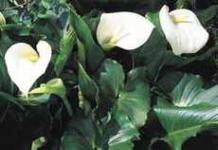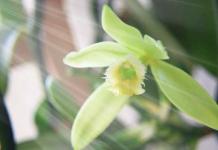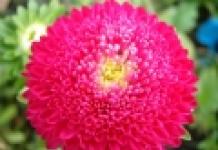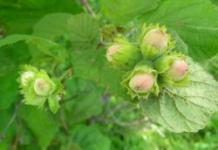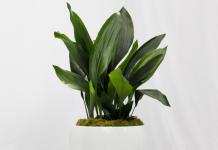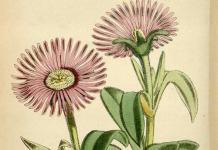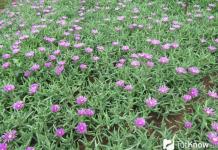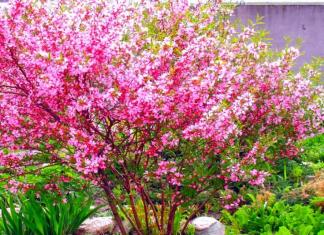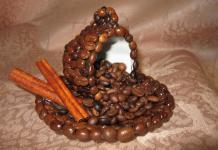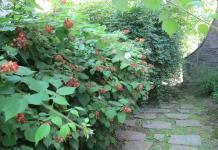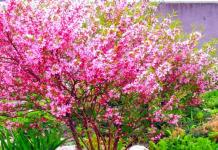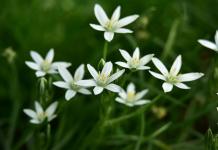And herbaceous plants (wild flowers),
20
colored laminated key tables, including: woody plants (trees in winter, trees in summer, shrubs in winter and shrubs in summer), herbaceous plants (flowers of forests, meadows and fields, reservoirs and swamps and primroses), as well as mushrooms, algae, lichens and mosses ,
8
colored determinants herbaceous plants (wild flowers) of central Russia (Ventana-Graf publishing house), as well as
65
methodical benefits And 40
educational and methodological films By methodologies conducting research work in nature (in the field).
FAMILY Araceae, OR ARONIC - ARACEAE
Aroid - one of the large families of monocots, including about 110 genera and over 1800 species distributed mainly in the tropical and subtropical regions of both hemispheres. There are many aroids in temperate regions, and some of them even enter subarctic regions, but their species and generic diversity outside the tropics is small (less than 10% of species).
Representatives of the family - terrestrial, marsh, rarely aquatic herbs with tubers or more or less elongated rhizomes. In tropical countries, aroids often reach gigantic sizes. Many among them vines and epiphytes .
branching stems aroid usually sympodial, rarely monopodial. Most erect forms, even giant grasses, do not have aboveground vegetative stems, which are replaced by tubers and rhizomes. However, climbing plants have such long aerial stems that they can no longer support themselves in an upright position. They usually rest on trees and are held on them with the help of adventitious air roots-trailers. These roots do not show geotropism, are negatively heliotropic and are very sensitive to contact irritation. They depart from the side of the stem turned to the support tree, grow horizontally, sometimes reaching a considerable length, and “stick” to the bark of the support tree with the help of special hairs. No less common in aroids and nourishing aerial roots . They are more powerful and, in contrast to the previous ones, appear on the free side of the stem that is not pressed against the support. These roots grow vertically down and hang freely or crawl down the bark of the support tree. Finally, they reach the soil, penetrate it and branch intensively, increasing the active suction surface, and thereby help to provide the plant with moisture and mineral nutrition. Air nourishing roots extract moisture in another way. Their surface is covered with a peculiar, usually multilayer integumentary tissue - velamen - and through its dead cells, condensing atmospheric moisture is absorbed by capillary action, like a sponge. In the roots of aroids, vessels with scalariform perforation are common, but in the stems they are extremely rare, and the water-conducting elements are represented mainly by tracheids.
Leaves aroid alternate, in most cases divided into petiole and blade, ground or stem, of different sizes and structures. The extreme diversity of the leaf blade is striking, but simple whole wide blades with reticulated venation predominate. However, there are all transitions to giant leaves with complexly dissected plates and powerful petioles. The primitive members of the family have leaves typical of monocots: narrow, long, with parallel venation, vaginal and without petioles. The shape and dissection of the leaf blade often change strikingly during the life of the plant. In many aroids, the dissected large leaves of adult plants differ significantly from the small whole leaves of their juvenile shoots, as is clearly seen in Monstera thin ( monstera tenuis). The leaf blade is almost completely reduced in the hanging shoots of stolons. The structure and shape of the blade can change significantly during the life of the leaf, and this is especially clearly seen in the formation of peculiar perforated leaves, characteristic of many aroids.
The structure of the petioles is also varied in aroids. In the morphological series of changes from petiolate leaves with sheaths to petiolate leaves without a sheath, there are many intermediate forms in which the petiole also functions as a sheath and, accordingly, has a dual structure: from the outside it looks like a typical petiole, and from the inside it looks like a typical sheath. Characteristic of aroid and other modifications of petioles. In epiphyte philodendron thick (P. crassum), the petiole serves as a store of moisture, it grows strongly in thickness, becomes watery, yellowish and resembles a succulent stem.
In aroids, elements of excretory tissues are abundant and diverse. These are separate secretory cells - idioblasts - with single crystals of calcium oxalate, druses, raphids, secretory cells, intercellular trichosclereids, as well as schizogenic receptacles, resin canals, and especially common articulated lactifers. In addition to the excretory function, many of these formations play the role of protecting the plant from being eaten by animals.
Aroids have only one inflorescence type - an ear, on which it is usually very dense, in series of spirals, small nondescript flowers devoid of bracts are placed, which cannot always be clearly distinguished.
flowers bisexual or unisexual; bisexual flowers in most cases with 4-6-membered perianth, rarely glabrous; unisexual flowers are usually naked and only as an exception with a perianth. There are 4-6 stamens, but their number can be reduced to 1 or increase to 8. The stamens are free or grow together into specific formations - synandria. In specialized groups, the filaments of the stamens are reduced and the overgrown connective tissue turns the stamens into a kind of geometric figures: prisms, squares, truncated pyramids. Anthers ovate or linear-oblong, opening with pores, longitudinal or transverse slits. Pollen grains with a shell of various types. Gynoecium cenocarpous with 2-3 (up to 9) carpels, sometimes pseudomonomeric; ovary superior, only sometimes immersed in the fleshy axis of the inflorescence, 1-3-locular, with one or many ovules in each nest. Embryo with abundant endosperm or sometimes without it. The fruit of almost all aroids is a single or multi-seeded berry, usually brightly colored.
In aroids bloom takes place in 2 phases. First, the stigmas function (the female phase of flowering), and only after they lose their ability to perceive pollen, the anthers open (the male phase of flowering). Protogyny occurs in plants with bisexual and unisexual monoecious flowers. The sequence of female and male flowering phases prevents self-pollination, but this is not always achieved in aroids. The lower flowers enter the female phase first, and their flowering usually proceeds strictly from bottom to top along the cob. The development and opening of the anthers, as a rule, does not have such a sequence. Often, in the upper flowers or even in the flowers in the middle part of the cob, the flowering phases coincide and self-pollination becomes possible. This also applies to geitonogamy, which is fairly common in aroids. Thus, protogyny does not protect the flowers of aroids so reliably from self-pollination, and the development of other mechanisms was required to prevent it. One of them is the structure of the inflorescence itself. The evolution of inflorescences in the family follows the path of an increasingly sharp delimitation of the female parts of the flower and inflorescence from the male. And if primitive aroid flowers are bisexual, then at the end of the evolutionary series, the most specialized groups have same-sex flowers, and female and male are located in different parts of the inflorescence or even on different plants (dioecious flowers in a number of arizems - Arisaema). Self-pollination in this case is perfect.
inflorescences aroids are striking in variety and, with rare exceptions, look like single flowers. This impression is created mainly due to the modification of the cover (covering sheet) of the inflorescence, often brightly colored and taking the form of a perianth. Sometimes it is so bizarre that the inflorescence can be mistaken for an exotic orchid flower or a pitcher leaf of insectivorous nepenthes. But the differences are not only in size, the inflorescences also differ in many essential features, showing a different degree of their evolutionary advancement. The most primitive inflorescences, bearing only bisexual flowers on the cob, are characteristic of the most primitive aroids. In more specialized subfamilies, only unisexual flowers develop. Two zones of flowers are formed on the cob: the lower one is from female flowers, the upper one is from male ones. Then, in the area of their contact, a zone of sterile flowers appears, and sometimes even a second zone of sterile flowers is formed at the top of the cob. In some cases, sterile flowers are reduced, and then the female part of the inflorescence is separated from the male only by a bare section of the sterile axis of the inflorescence. In some aroids, the upper sterile flowers form an appendage of the cob, often turning into the so-called osmophore - a carrier of an odor that attracts pollinators. In some species, this appendage acquires a bizarre shape of a mushroom cap or becomes filamentous. Modified sterile flowers also play a role in insect pollination, especially in specialized aroids. Within the family, in parallel with the complication of the structure of the inflorescence, the structure of flowers was simplified, and in specialized subfamilies, the female flower usually consists of only one gynoecium, and the male flower is often reduced to 1 stamen or 1 synandria. Often, male flowers on one inflorescence consist of a different number of stamens (as, for example, in amorphophallus), and then it is very difficult to determine the border of an individual flower.
In connection with the specialization of the inflorescence, the changes in the cover of the inflorescence are also interesting. In calamus, it does not differ from an ordinary leaf and quickly falls off. But in most specialized groups, the veil completely or partially covers the inflorescence, performing, in addition to protective, other functions.
The bright color of the bedspread, characteristic of many species, attracts pollinating insects; the special structure of the bedspread of trap inflorescences helps to “catch” pollinating insects and keep them in the inflorescence in the area of female flowers. The two-chamber spathe in Cryptocoryne species ( Cryptocoryne) prevents self-pollination and protects the inflorescence from getting wet.
Pollinated Aroid flowers are predominantly insects (flies, bees, beetles, aphids). Snails are of some importance in pollination, although disputed by some researchers; in some cases, wind pollination is not excluded. Aroids are characterized by a special kind of entomophily - sapromyophilia - pollination by dung and carrion flies. In this case, the plant turns out to be an active member, as it were, it forces insects to pollinate flowers against their will. To do this, a number of special structures are formed in the plant, designed to deceive the insect. By imitating the smell and color of the substrate in which these insects lay their eggs, the plant literally invites pollinators into the trap inflorescence and keeps them captive until they pollinate the flowers and receive pollen to pollinate the flowers of other inflorescences. In sapromyophilic aroids, flowering is accompanied by a completely unusual phenomenon for higher plants, described by Lamarck more than 200 years ago, but still of interest to scientists. This is a sharp increase in the temperature of the inflorescence or its individual parts by 10, 16 and even 30 ° C compared to the ambient temperature. But the close connection between the rapid rise in temperature and the equally rapid appearance of an extremely unpleasant odor from the cob is especially remarkable. Both of these phenomena are short-lived and usually disappear after a few hours. Subsequent studies have established that the appearance of odor is coupled with a huge metabolic activity in the inflorescence and is associated with excessive respiration activity, which itself can lead to an increase in temperature. Under the influence of heat, the volatile substances that carry the smell begin to evaporate, and the spreading stench attracts pollinating flies. A chromatographic study of the substances that make up the smell of the aroid cob revealed another interesting link in the chain of phenomena under consideration - an unusually fast, explosive increase in the amount of free amino acids in the tissues of the inflorescence during the opening of the anthers. The unpleasant smell emanating from aroid inflorescences is sometimes associated with another type of pollination - saprocantharophilia, as, for example, in giant amorphophallus. The disgusting smell of the inflorescence attracts dung beetles and carrion beetles - its constant pollinators. Many aroids from different kinship groups use bees, wasps, and aphids as pollinators and attract them with a pleasant floral scent and a sweetish nectar-like liquid. Aroids do not have morphologically pronounced nectaries, and a sweetish liquid that performs the function of nectar is secreted from them by various organs of the flower.
Within the aroids, they usually secrete 9 subfamilies . Starting from the most primitive, they form the following series of increasing specialization: calamus ( Acoroideae), streaming ( Pothoideae), monster ( monstereae), calla ( Calloideae), lasian(Lasioideae), philodendrous ( Philodendroideae), taro ( Colocasioideae).
to keep an exotic plant at home, you need to know the intricacies of care. Most people love colorful plants. The conditions for breeding large groups of flowers are the same. Each living being requires individual care. In this collection, we tried to cite several articles in order to avoid death when keeping an unusual plant. It should be determined in order to determine the correct procedures, which class your flower belongs to.
General information about aroid
The aroid family (lat. Araceae) includes some of our wild ones - in the lowlands there is a poisonous calla with an ear of red berries; calamus with saber-shaped leaves grows along the banks of reservoirs, its fragrant root is edible and has medicinal value, Far Eastern arizema.
In room conditions and greenhouses, alocasia, anthurium, spathiphyllum, monstera, philodendrons, syngoniums, caladiums, dieffenbachia, aglaonemas are grown ... This endless list can be continued further with rarer names that most of us do not even suspect. A significant part of aroid plants has not only a bright color and an unusual shape of leaves, but also blooms excellently.
All plants of the aroid family have flowers located on the inflorescence - the cob in the form of a rod or mace. The name of the family, according to the Hebrew legend, speaks of the miraculous rod of Aaron. This wand allegedly became covered with buds, almond flowers and even nuts overnight. It is a large cover that is the main thing in assessing the decorative qualities of plants (calla, anthuriums, spathiphyllums). Many domestic aroids in room conditions bloom extremely rarely (or do not bloom at all) and at the same time they usually have a nondescript small veil, but they amaze with the color, shape and size of the leaves. Aroid fruits are juicy berries, in many species with a pleasant aroma, edible.
Tuberous aroids
Tuberous aroids are divided into two groups, depending on the depth of the dormant period. One - with a long and deep dormancy (caladiums, sauromatums), the second - with a short-term and mild (Zantedeschia, alocasia). A small part of the aroids behaves like true epiphytes. Plants grow and develop without coming into contact with the soil and remaining on the trees all their lives. The most typical life form of aroids are creepers, which are divided into root-climbing and creeping. Many of them are semi-epiphytes.
Callas (Calla L.)  We are especially fascinated by charming calla lilies (Zantedeschia), or as it is also called Calla. The plant is so loved by the people that it can be found in almost any flower shop or specialized department. They surprise already at the appearance of the first sprouts. Even on the smallest leaf, white strokes are clearly visible, which give them a decorative effect for the entire growing season. In addition, each variety has its own shape and shade of leaves, its own bush height. In recent years, variegated varieties have been especially popular.
We are especially fascinated by charming calla lilies (Zantedeschia), or as it is also called Calla. The plant is so loved by the people that it can be found in almost any flower shop or specialized department. They surprise already at the appearance of the first sprouts. Even on the smallest leaf, white strokes are clearly visible, which give them a decorative effect for the entire growing season. In addition, each variety has its own shape and shade of leaves, its own bush height. In recent years, variegated varieties have been especially popular.
Caladium (Caladium) Tuberous stemless plant with beautifully colored arrow-shaped leaves. Translated from the language of the local natives, Caladium means "a plant with edible roots." In culture, hybrids are common with the most unusual combinations of leaf colors of green, white, carmine, purple, pink and yellow. The plant does well in a semi-shady or bright place without direct sunlight. High humidity is required, it is dormant in winter, dropping all the leaves, so the pot with tubers is installed in a cool place. In March, when growth resumes, watering is increased. Leaves in winter are preserved only with additional lighting ... - see below
 Of the most exotic flowering aroids, one can name representatives of the genera Arum, Arizema, Amorphophallus, Steudner, Sauromatum, etc.
Of the most exotic flowering aroids, one can name representatives of the genera Arum, Arizema, Amorphophallus, Steudner, Sauromatum, etc.
Sauromatum (Sauromatum) A tuberous plant from the aroid family with an unusual appearance and an interesting vegetation cycle. It is also called arum dracunculus (sauromatum). The name comes from the word "saura" - a lizard, given because of the spotted wing. This plant is more original than beautiful. Flowers appear already in May, after a dormant period, and only from large tubers, although it is completely without leaves. It blooms until the appearance of a new, only one large dissected leaf, which dies off during the dry period. The inflorescence is an ear of brownish-red color. Spathe 50-100 cm long and 10-15 cm wide, purple on the outside, yellowish-green inside with purple spots. Flowering is short and in the sun the flowers exude a specific aroma, which attracts flies and other insects.
In the middle lane, tubers are dug up for the winter and stored in a cold place. Can be stored in the refrigerator, overlaid with dry sphagnum moss, placed in a plastic bag. Periodically check the condition of the tuber. If a sprout begins to develop, then it is placed in a colder place. Planted in the garden in April-early May. It can be planted in a pot in the spring, as soon as it starts to grow.
Amorphophallus (Amorphophallus)  A very large herbaceous tuberous plant from the aroid family, which is one deeply dissected leaf blade on a straight, smooth, covered with reddish-brown spots, rather thick petiole up to 1 m high. At home it was called "snake tree". During dormancy, the plant sheds a single leaf. Tubers are stored at a temperature of 12-15 degrees. Starting to grow, it can first form a flower arrow bearing an inflorescence-cob enclosed in a covering leaf of dark red or brown color. During flowering, it emits a very unpleasant smell of rotting meat, attracting pollinating flies. Amorphophalluses are cultivated only in greenhouses and conservatories due to the very large size of the inflorescences.
A very large herbaceous tuberous plant from the aroid family, which is one deeply dissected leaf blade on a straight, smooth, covered with reddish-brown spots, rather thick petiole up to 1 m high. At home it was called "snake tree". During dormancy, the plant sheds a single leaf. Tubers are stored at a temperature of 12-15 degrees. Starting to grow, it can first form a flower arrow bearing an inflorescence-cob enclosed in a covering leaf of dark red or brown color. During flowering, it emits a very unpleasant smell of rotting meat, attracting pollinating flies. Amorphophalluses are cultivated only in greenhouses and conservatories due to the very large size of the inflorescences.
Arizema (Arisaema) An unusual and rare tuberous plant from the aroid family. Arizema leaves pinnately dissected or crescent-shaped with wide or narrow lobes. Flowers collected on the cob have no decorative value. A feature of this plant is dioecious flowers, so two plants with female and male flowers are needed for cross-pollination.
Arizema open (A. ringens) - in nature can be found in Japan. The tubers of this plant are flat, the leaves have an oblong-oval shape with an expanded base. The leaf blade is divided into three segments. The upper edge of the sheet is colored green; the lower one is greyish-green. During flowering, an open arizema releases a peduncle (up to 20 cm) with an inflorescence-cob located on it. On the male plant, the flowers are densely arranged on the cob, on the female - scattered. In the upper part of the inflorescence, the flowers are asexual. The spadix is covered with a veil that is wide-toothed in the lower part and lamellar in the upper part. The color of the bedspread is grayish-brown, the inside is decorated with white longitudinal stripes.
Aronnik (Arum) Aroid family (Araceae). It comes from the ancient Greek word "aron" - the name of one of the species of this genus. Small dormant perennial herbs with hemispherical or ovoid horizontal tuberous rhizomes.
List of genera in the family Araceae
Plants from the aroid family, or Aronnikovae, attract us more and more. This is one of the largest families of monocot plants, including about 150 genera and more than 3000 species, distributed mainly in tropical and subtropical regions of both hemispheres. There are many aroids in temperate regions, and some of them even enter subarctic regions, but their species and generic diversity outside the tropics is low (less than 10% of species).
A very great contribution to the study of plants of the Aroid family was made by the Austrian botanist Heinrich Wilhelm Schott. The genera described by him are supplemented by the abbreviation "Schott".
There is a specialized magazine "Aroideana", which publishes serious scientific articles about various members of the family. Aroids are so diverse that special exhibitions are dedicated to them. There is the International Aroid Society, founded in 1978 and uniting not only scientists - botanists, but also numerous amateurs.
Many life forms are represented among the aroids. These are marsh and aquatic plants - hydrophytes (cryptocorines, lagenanders, anubias), and even aerohydrophytes, with the only non-typical representative - pistia telorezovidny.
HouseplantsAroid family
The Aroid family, or Aronnikovye, belongs to monocotyledonous perennial plants. They include about 150 genera and over 2,000 species of terrestrial herbaceous plants, sometimes aquatic perennials, as well as creepers and epiphytes. Also, the Arroniaceae family is known for its poisonous milky juice, which is present in numerous plant species.
Representatives of the Aroid family are mainly plants growing in an earthen environment, which are also often found in swampy areas. However, there are herbs that live in the aquatic environment, having tubers or elongated rhizomes. Mostly plants of the Aroid family grow in the tropics and in areas with a moderately warm climate. The natural tropical growth environment causes almost all types of plants to achieve large and fairly large sizes.
It is worth noting that almost all plants of the family are very resistant and not whimsical to various factors and habitat conditions, therefore they are also not uncommon in natural habitats and on the territory of Russia. For example, in some areas of the middle lane, where, as a rule, there is not enough sunlight, even quite demanding certain types of plants can be grown.
The leaves, as a rule, have petiolate, arrow-shaped and broadly elliptical forms that extend from a tuber or creeping rhizome, inherent in most terrestrial plants of the aroid family. Some species have a fairly short stem, or its complete absence. For example, amorphophallus has such a leaf in a single copy and is deeply dissected. But creepers, known to everyone as entwining plants - philodendron, monstera - are attached to tree trunks with the help of many aerial roots.
A characteristic feature of the family is the inflorescence - the cob. Among the family, small-sized flowers are widespread, which outwardly seem like single flowers. The inflorescence is always covered with a covering leaf, which is usually green in color or other color tones close to green.
Flowering in representatives of the Aroid family is most often accompanied by a smell, which attracts insects for pollination of flowers. Covering leaf - often a trap for some insects, such as pollinating flies. It is worth noting that many species are fruit berry crops, however, there are both juicy and dry fruits that have their own unique specific taste and aroma, unlike other plant fruits. An interesting fact is also that some types of plants of the Aroid family have edible cobs, such as Monstera.
Due to the presence of calcium oxalate crystals found in the leaves and cobs of many plants, the use of the fruits and leaves is also well practiced in medicine, various tinctures, or special ointments with the addition of the necessary elements, are used to treat rheumatism or back pain, mainly as a rubbing agent.
Some types of plants, such as Anthurium, Spathiphyllum and many others, are used as indoor ornamental plants, for landscaping rooms and creating a more pleasant interior. It is worth noting that their difference is bright inflorescences. Plants such as Amorphophallus and Aglaonema are distinguished by their unusual colors and color tones of the leaves. Pistiyateloreznaya is bred as an aquarium plant.
In places with a tropical mild climate, plants of the Aroid family decorate gardens and are used as vertical gardening of a fence, where climbing plants or creepers are very popular. Features of certain plant species of the Aroid family testify to their rich diversity, as well as their abundance and plant uniqueness.
The most famous tropical crop of this family is the taro plant, which is grown as a source of starch, having starchy tubers that resemble potatoes but are larger. Food plants are also Xanthosoma "Arrowleaf", Alocasia "Large-root", which grow in Southeast Asia.
In places of greatest natural growth and distribution, namely in Central and South America, some plants, including Syngonium, are large and fast-growing vines. Syngonium is interesting primarily for its color, as well as a distinctive feature - with age, change the color of its leaves. Young specimens have a rich and bright green color of their arrow-shaped leaves, growing on a straight stem that does not require support, but during growth and development, the stem of the plant gradually develops and there is a direct need for support, which can serve as a number of growing trees.
Caladium is one of the brightest and most beautiful plants of the Aroid family, which has a variety of leaf colors. But it is worth noting that the brightness and beauty does not last long and is limited to the time period from February to August, after which the leaves wither and fall off.
Aglaonema - is considered a rather demanding plant in terms of lighting conditions. The lack of natural light requires its artificial illumination, but the Philodendron, on the contrary, is quite shade-tolerant.
Botanical description. Members of the family are terrestrial, marsh or aquatic herbs with tubers or more or less elongated rhizomes. In tropical countries, aroids often reach gigantic sizes. Many of them are lianas and epiphytes. Stemless or short-stemmed terrestrial aroids often have petiolate leaves, swept or broadly elliptical, extending from a creeping rhizome or tuber. In amorphophallus (Amorphophallus), this leaf is the only one, deeply dissected. Creepers that wrap around tree trunks - monstera (Monstera), philodendron (Philodendron), scindapsus (Scindapsus) - are attached to them with numerous aerial roots. Many aroids contain poisonous milky juice. The inflorescence is an ear, consists of numerous small flowers, but often looks like a single flower; it is completely or partially covered with a green or otherwise colored covering sheet - a bedspread. Sometimes flowering is accompanied by a specific unpleasant odor that attracts insects, especially flies that pollinate flowers. The spathe of some aroids is a kind of trap for such pollinators. Fruits are most often berry-like, less often dry, cracking. Currently, within the aroids, 8 subfamilies or 9 (together with the Airaceae subfamily) are distinguished: Aroids (Aroideae)
Gymnostachis (Gymnostachydoideae)
Calla, or Calla (Calloideae)
Laziye (Lasioideae)
Monster (Monsteroideae)
Orontiaceae (Orontioideae)
Pothos (Pothoideae)
Duckweeds (Lemnoideae)
Healing properties and application. Aronnik spotted. The homeopathic remedy Arum, obtained from Arum spotted, is quite popular for the common cold, inflammation of the oral mucosa, catarrh of the upper respiratory tract, mumps, scarlet fever and measles. Arum helps in almost all cases of hoarseness when the vocal cords are overstretched, such as when a singer or speaker cannot sing or speak loudly. Take it in dilution D1-D6 several times a day, 3-5-8 (up to 10) drops. You can also gargle with a highly diluted tincture: 5 drops in a glass of warm water.
Air ordinary. Calamus belongs to the group of aromatic bitterness and therefore is applicable for gastrointestinal diseases and diseases of the biliary system, with loss of appetite and for a general increase in the tone of the digestive tract. Especially good calamus helps with gastrointestinal diseases, the cause of which should be sought in the autonomic nervous system. Calamus is valued in folk medicine as a remedy for disorders in the digestive system as a whole. Moreover, calamus rhizome tea is used as a cleanser against skin rashes and dandruff. Calamus essential oil obtained by steam distillation or alcoholic extract from calamus rhizomes is also used as a rub against rheumatic ailments.
In some species, for example, in Monstera deliciosa, the cobs are edible. The presence in the leaves and cobs of aroid crystals of calcium oxalate allows them to be used as a distracting (irritating) rubbing agent for rheumatic pains. Species of the genera zantedeschia (known as callas in floriculture), anthurium (Anthurium), spathiphyllum (Spathiphyllum) are used in indoor floriculture for the sake of bright inflorescences, and types of dieffenbachia, caladium (Caladium), aglaonema (Aglaonema), amorphophallus (Amorphophallus) - for the sake of a peculiar , sometimes unusually colored foliage. Lianoid aroids - philodendron, syngonium (Syngonium) - are used for vertical gardening. A floating plant, Pistia stratiotes, is bred in aquariums. One of the widespread tropical crops belongs to the aroid family - taro, or edible taro (Colocasia esculenta), grown for the sake of large starchy tubers. As food plants, the arrow-leaved xanthosoma (Xanthosoma sagittifolium) from the West Indies and the large-rooted alocasia (Alocasia macrorhiza) from Southeast Asia are also bred.
Add site to bookmarks
features of the development of aroid plants at home
Lovers of a home green corner are happy to use aroid plants to create it. These indoor flowers have a very amazing leaf shape, the colorful range of which is striking in its unusualness and variety of shades. And what can compare with a zantedeschia flower? A soft white cone with an elongated yellow center, as if fashioned from the first snow. It captivates and makes you admire yourself for hours. Therefore, you can confidently purchase flowers of this family and fill them with any space in your interior. Admiration and positive emotions are guaranteed.
One of the largest families growing in this climatic zone are aroids.
Aroid plant family
Tropical and subtropical forests do not cease to give their contemplators more and more specimens of exotic plants. One of the largest families growing in this climatic zone are aroids. Their quantitative composition includes more than 3,000 representatives. The famous Austrian botanist Heinrich Schott studied and described many species of these plants. The life forms of this family amaze with their ability to adapt to any conditions. Some of them grow in swampy areas, others - right in the water. They are called hydrophytes. Bright representatives of this landscape are Cryptocoryne, Lagenander, Anubias. A special exoticism is carried by aerohydrophytes with their brightest representative - telorezoid pistia. These are monocot plants. The arrangement of the leaves is alternate. The base of the root is tightly attached to the stem. The aroid flower is quite large and in shape resembles a leaf twisted into a cone. The color scheme is diverse - from snow-white to black shades.

For aroid plants, the soil must be constantly loosened for good oxygen access.
And the name of the whole family comes from arum. It is called Palestinian or sacred. The root of this plant resembles tubers, the leaves look like arrows with a wide upper part. Their color is rich green, closer to its dark shades. Flower cob oblong shape. Around it is a beautiful shiny veil. Interest in the aroid family is very great. Features of the structure and growth of representatives are described in scientific journals, one of which is named after the family.
In 1978, a society was founded that has an international status, which includes dozens of botanists and just lovers of aroid plants.
Numerous conferences of this society help to study the features of the development of this family even more accurately, to learn about its new representatives.
Back to index
Features of caring for aroids at home
By purchasing this or that houseplant from this family, every housewife wants to prolong its existence as long as possible. After all, how pleasant it is to look at a flower with juicy leaves of saturated color, lovely buds, which grows and develops precisely from our care for it. To do this, it is necessary to create conditions in the room that will be as close as possible to the real habitat in the wild. A group of aroids that grow in belts with fluctuating rainfall, usually shed their leaves and "fall asleep" during a rainless period. Therefore, at home, if you notice the disappearance of the leaves, you should not water them as usual. It is best to move the plants to a place where there will be a minimum of light and heat. These members of this family include:
- Arizema;
- Arum;
- Arizarum;
- Caladium.
A family of vine-shaped aroid plants growing in tropical forests with very high humidity. They climb tree trunks so high that sometimes such a distance corresponds to 20 meters. Adventitious roots help them to strengthen. They grow into the trunk, covering it with their lateral roots, which perform the same function as in the ground. Lateral roots store water and nutrients.
Such liana-like aroids also have an air root system. It descends to the forest floor, which in the tropical forest can be more than 50 cm and is saturated with everything necessary from it. Therefore, caring for anthurium, monstera, philodendron, syngonium should involve special frames along which these plants will branch out, and abundant watering. The aerial roots of these plants can be overlaid with moss, which must be constantly wet.
The peculiarity of spathiphyllums, alocasias, dieffenbachias, aglaonemes is that muddy soil is necessary for their normal growth and development. Ordinary soil will not be able to saturate these plants with all the necessary trace elements and minerals. Therefore, flower growers recommend mixing soil with turf, dry leaves, humus, sand and birch charcoal before planting. The soil must be constantly loosened for good access to oxygen. In temperate climates, when hot summers are replaced by cold winters with rainy weather, frost, lack of sufficient lighting, indoor plants can be moved to the western, eastern or northern sides in summer, and to the south in winter. These changes are well justified. Indeed, in summer and spring, shade and protection from the scorching sun are created, and in autumn and winter, the lack of light and heat is replenished.
Plants of the aroid family are considered the most ecologically plastic.
They are more than all the other indoor flowers were able to adapt to life in our apartments. So let's not forget about it and be happy to help them delight us with the riot of their colors and variety of shapes!
In room culture, many plants from the Aroid family (Araceae) are known.
This is one of the largest families of monocots, including more than a hundred genera and up to 2 thousand species. Aroids in nature are found mainly in the tropics and subtropics, some species are also found in the temperate zone. Among the representatives of this family there are herbaceous and bushy plants, creepers, epiphytes.
Many species have tubers or rhizomes that serve as stores of moisture and nutrients. Lianas, for example, often have aerial roots. With their help, climbing plants cling to a support and receive additional nutrition when the roots reach the soil.
Aroid leaves are distinguished by a wide variety of structure, color and size. They have wide whole green leaf blades on long petioles. In adults, monstera and philodendrons have dissected or perforated leaves, although in young plants they are whole. A complex leaf has many leaf blades on one petiole.


U, leaf blades are large oblong, most often variegated in color. In too dark rooms, the leaves lose their variegation. Almost all species are characterized by pronounced veins of a lighter color.
The most beautiful and brightest leaves at. But this plant grows from the end of winter to the beginning of autumn, then there is a dormant period, and the leaves disappear.

Inflorescences in all common indoor aroids are on the cob. Flowers do not differ in beauty, they are small and inconspicuous.
But what about red glossy flowers or white flags? In fact, these are not flowers, but a veil - a modified leaf that covers the inflorescence from adverse conditions.
Under natural conditions, the bright color of the bedspread, characteristic of many species of aroids, and the strong smell of the inflorescence (not always pleasant) attract pollinating insects. Most species common in room culture are odorless.
Due to the wide variety of aroids, it is difficult to single out general rules for caring for them, but most are characterized by:
- Aroids do not like drafts and sudden changes in temperature. Even the slightest draft from a window ajar in winter can cause the leaves to turn yellow and drop.
- In summer, all aroids need to be shaded from too bright sun, it is advisable to keep plants on windows facing east and west, and in winter, when there is not enough sunlight, on southern windows.
- The aerial roots of aroids cannot be cut, it is better to wrap them with wet moss and send them to the ground in pots.
- Almost all aroids are moisture-loving, in spring and summer they need to be watered abundantly (with the possible exception of). In winter, water less, but the soil should not dry out.
- The soil should be loose: a mixture of light, earth and sand with the addition of,.
- Almost all representatives of the aroid family reproduce by cuttings, spathiphyllums can be propagated by dividing the bush during transplantation.
- Many aroids are poisonous, so they should not be placed in a nursery, cut preferably with gloves, or wash your hands well immediately.

The family of monocotyledonous plants Aroid Araceae has more than a hundred genera and about two thousand species. The distribution area of aroids is very wide - tropical, subtropical and even temperate zones on different continents of both hemispheres of the Earth, but the vast majority of members of the family are tropical plants. Many aroids contain poisonous milky juice.
An extensive family of plants of graceful form with beautiful coloring of leaves with cob-shaped inflorescences. The cob consists of many small flowers, but outwardly looks like a single flower. The size of the inflorescence is from small to very large, even gigantic. At the same time, in some aroids, the spathe tightly closes the spadix, while in others it is widely bent.
Anthurium and some other aroid plants have colored bedspreads or wings of various colors (white, pink, red, etc.) or are distinguished by the beautiful shape and color of the leaves. In many genera of aroids, the inflorescences have an unpleasant odor calculated to attract flies and other insects for pollination.
The leaves of the aroids are arranged alternately, the base of the petiole tightly covers the stem, usually the petioles are quite long. The large leaves of some aroids have a metallic sheen, while others are velvety, with various shades of green or variegated. The shape of the leaves is arrow-shaped, heart-shaped, palm-shaped, in rare species there are non-petioled belt-shaped leaves. The shape of the plant itself is bushy and vines, there are upright plants and giant decumbent grasses.
Among the aroids there are terrestrial plants and epiphytes. And also quite a lot of wetland plants. By the way, it is the aroid family that belongs to the smallest flowering plants on Earth - the genus Wolffia - Wolffia rootless Wolffia arrhiza. These are green plates floating on the surface of the water about 1 mm in diameter. And lo and behold - these crumbs are blooming! Aquarists raise babies.
Due to this diversity, the aroid family is divided into 8 subfamilies (Aroid Aroideae, Gymnostachis Gymnostachydoideae, Callal or Calloideae Calloideae, Lasia Lasioideae, Monster Monsteroideae, Orontium Orontioideae, Pothos Pothoideae, Lemnoideae)
Aroid care
- In summer, keep plants on windows facing north, east and west, and in winter on windows located on the south side of the house. Those. in spring and summer you need shading from midday sunlight, and in winter the lighting should be very good, so direct rays are only useful.
- Wrap the stem and aerial roots of aroid moss, cover the ground in pots with it, since there are usually many roots on the surface of the pot, keep the moss moist.
- Almost all aroids are moisture-loving and require abundant watering in the spring and summer (with the exception of succulent plants, such as zamiakulkas). For vines and bushy aroids, watering is somewhat reduced in autumn, but the soil should not dry out. Tuberous aroids, after they shed their leaves, do not water until the moment of new growth.
- For most aroids, the soil should be something like this: a mixture of light soddy, humus, leafy soil and sand with the addition of birch charcoal. The main requirement for the soil is looseness.
Almost all aroids love high humidity. True, it should be noted that they tolerate dry air in different ways - some require regular spraying, especially in summer and during the heating season (alokaziya, anthurium), others can do without spraying if they are not kept in close proximity to a heat source (spathiphyllum, scindapsus).
Reproduction of aroid
Most aroids are fairly easy to breed. Lianas are propagated, as a rule, by cuttings or layering with aerial roots. Tuberous aroids with the beginning of growth form many onions - children. Many aroids can be propagated by seeds, but this is not practiced in all genera, since the seeds quickly lose their germination capacity.
By the way
Transplantation requirements for aroids are different - some of them are not very demanding on the soil (amorphophallus cognac, scindapsus) and quite easily tolerate transplantation (syngonium). But rhizomatous aroids, as a rule, tolerate transplantation worse if the bush was divided at the same time, and can get sick for a long time (spathiphyllum, aglaonema)
This is interesting
The French scientist Jean-Baptiste de Lamarck noticed about 200 years ago (1803-1815) that the temperature of the inflorescences of flowering Zantedeschia aethiopica rises significantly above the ambient temperature.
A similar phenomenon was found in other representatives of the aroid family. Since then, botanists have become interested in an unusual phenomenon. And noted very original facts.
So it became known that plants of the aroid family, due to rapid respiration in the cells, release thermal energy. Moreover, the production of heat reaches colossal proportions. For example, an increase in the temperature of the inflorescence of philodendron 40 ° C higher than the air temperature, which was close to zero, was recorded (Nagy KA, Odell DK, Seymour RS. Temperature regulation by the inflorescence of philodendron. Science. 1972 Dec 15).
Scientists have calculated that at an air temperature of 10 ° C, 125 g of philodendron inflorescences produce approximately five times the heat energy of a rat weighing the same 125 g, under the same conditions.
The production of thermal energy occurs due to rapid respiration in the cells of thermogenic colors. Moreover, in most cases, in the studied thermogenic plants, carbohydrates, often transported from other parts of the plant, are the substrate for respiration.
But in Philodendron, the substrate for respiration is predominantly fats, and as you know, the oxidation of one molecule of fat provides more than twice as much energy as carbohydrates.
What is interesting: the thermogenic process has the opposite effect - on hot days, the temperature of the flowers (inflorescences) drops to 10 ° C below the ambient temperature, and due to the powerful evaporation of moisture.
Plant family Araceae (Araceae)
In room culture, many plants from the Aroid family (Araceae) are known.

Monstera
This is one of the largest families of monocots, including more than a hundred genera and up to 2 thousand species. Aroids in nature are found mainly in the tropics and subtropics, some species are also found in the temperate zone. Among the representatives of this family there are herbaceous and bushy plants, creepers, epiphytes.
Many species have tubers or rhizomes that serve as stores of moisture and nutrients. In creepers, in monstera, for example, aerial roots are often found. With their help, climbing plants cling to a support and receive additional nutrition when the roots reach the soil.
Aroid leaves are distinguished by a wide variety of structure, color and size. Anthuriums have wide whole green leaf blades on long petioles. In adults, monstera and philodendrons have dissected or perforated leaves, although in young plants they are whole. Zamiakulkas have a complex leaf - there are many leaf blades on one petiole.
The leaves of the scindapsus are small, whole; this vine grows as quickly as the syngonium.

dieffenbachia

Aglaonema
In dieffenbachia, aglaonema, leaf blades are large, oblong, most often variegated in color. In too dark rooms, the leaves lose their variegation.
Aroid at home
Almost all types of alocasia are characterized by pronounced veins of a lighter color.
Caladium has the most beautiful and brightest leaves. But this plant grows from the end of winter to the beginning of autumn, then there is a dormant period, and the leaves disappear.

Anthurium
Inflorescences in all common indoor aroids are on the cob. Flowers do not differ in beauty, they are small and inconspicuous.
But what about the red glossy anthurium flowers or the white flags of the spathiphyllum? In fact, these are not flowers, but a veil - a modified leaf that covers the inflorescence from adverse conditions.
Under natural conditions, the bright color of the bedspread, characteristic of many species of aroids, and the strong smell of the inflorescence (not always pleasant) attract pollinating insects. Most species common in room culture are odorless.
Due to the wide variety of aroids, it is difficult to single out general rules for caring for them, but most are characterized by:
- Aroids do not like drafts and sudden changes in temperature. Even the slightest draft from a window ajar in winter can cause the leaves to turn yellow and drop.
- In summer, all aroids need to be shaded from too bright sun, it is advisable to keep plants on windows facing east and west, and in winter, when there is not enough sunlight, on southern windows.
- The aerial roots of aroids cannot be cut, it is better to wrap them with wet moss and send them to the ground in pots.
- Almost all aroids are moisture-loving, in spring and summer they need to be watered abundantly (possibly with the exception of Zamiakulkas). In winter, water less, but the soil should not dry out.
- The soil should be loose: a mixture of light soddy, humus, leafy soil and sand with the addition of charcoal, coconut fiber, perlite.
- Almost all representatives of the aroid family reproduce by cuttings, spathiphyllums can be propagated by dividing the bush during transplantation.
- Many aroids are poisonous, so they should not be placed in a nursery, cut preferably with gloves, or wash your hands well immediately.

Alocasia

Caladium
Some popular houseplants in the Aroid family are:
Aroid family

General information about aroid
Aroid or Aronnikovye (lat. Araceae), a family of plants of the monocotyledonous class. Includes about 150 genera and more than 2000 species of herbaceous terrestrial, less often aquatic perennials, epiphytes and lianas. They are distributed mainly in tropical and also in warm temperate regions. There are many aroids in temperate regions, and some of them even enter subarctic regions, but their species and generic diversity outside the tropics is small, less than 10% of species. The brightest representatives: Stinky Symplocarpus (Symplocarpus foetidus) from the aroid family grows in the Far East and east of North America. The whole plant has a strong smell of garlic, poisonous.
Dieffenbachia (Diffenbachia), a genus of perennial plants of the aroid (aronic) family. 30 species, in the American tropics.
Diffenbachia spotted (Diffenbachia maculata) - a plant up to 1 m high. The leaf blade is oval or lanceolate, long pointed at the end, reaches 40 cm in length and sits on a petiole equal in size to it. Numerous varieties differ in the shape and color of leaves and petioles: leaf blades can be heart-shaped, covered with ivory strokes, numerous white spots, etc.
Dieffenbachia seguina (Diffenbachia seguina) differs from the previous species in a wider leaf and fewer white spots on it. The cultivar 'Camilla' has greenish-white leaves with a green border around the edge. The leaves of the popular variety "Tropic Snow" have an almost geometrically correct yellow-green pattern between the lateral veins.
Dieffenbachia, especially dieffenbachia seguina, are poisonous. The sap of this species causes burns to the mucous membranes and skin, which was used in the past by West Indian planters to punish slaves ("mute rod"). The extract from this plant in fascist Germany was going to be used to sterilize prisoners of concentration camps (Himmler ordered to grow dieffenbachia seguin in greenhouses in the camps, but the entry into the war on the side of Brazil's allies, from where the plants were supposed to be received, frustrated this plan). The genus is named after the German botanist J.F. Dieffenbach (1794-1847).
Taro is a tropical perennial plant in the aroid family. Large tubers (up to 4 kg, contain 25-27% starch) are eaten; cultivated in the tropics and subtropics of the Eastern Hemisphere. Plants are shade-tolerant, demanding on air humidity. Propagated by cuttings.
Botanical description. Members of the family are terrestrial, marsh or aquatic herbs with tubers or more or less elongated rhizomes. In tropical countries, aroids often reach gigantic sizes. Many of them are lianas and epiphytes. Stemless or short-stemmed terrestrial aroids often have petiolate leaves, swept or broadly elliptical, extending from a creeping rhizome or tuber.
The difficult nature and bright appearance of aroid houseplants
In amorphophallus (Amorphophallus), this leaf is the only one, deeply dissected. Creepers that wrap around tree trunks - monstera (Monstera), philodendron (Philodendron), scindapsus (Scindapsus) - are attached to them with numerous aerial roots. Many aroids contain poisonous milky juice. The inflorescence is an ear, consists of numerous small flowers, but often looks like a single flower; it is completely or partially covered with a green or otherwise colored covering sheet - a bedspread. Sometimes flowering is accompanied by a specific unpleasant odor that attracts insects, especially flies that pollinate flowers. The spathe of some aroids is a kind of trap for such pollinators. Fruits are most often berry-like, less often dry, cracking. Currently, within the aroids, 8 subfamilies or 9 (together with the Airaceae subfamily) are distinguished: Aroids (Aroideae)
Gymnostachis (Gymnostachydoideae)
Calla, or Calla (Calloideae)
Laziye (Lasioideae)
Monster (Monsteroideae)
Orontiaceae (Orontioideae)
Pothos (Pothoideae)
Duckweeds (Lemnoideae)
In other taxonomy classifications of the family, the subfamily Airaceae (Acoroideae) is separated into a separate family Airaceae (Acoraceae); and the previously independent family of Ryaskovye (Lemnaceae) is included in the Aroid family at the rank of subfamily.
Healing properties and application. Aronnik spotted. The homeopathic remedy Arum, obtained from Arum spotted, is quite popular for the common cold, inflammation of the oral mucosa, catarrh of the upper respiratory tract, mumps, scarlet fever and measles. Arum helps in almost all cases of hoarseness when the vocal cords are overstretched, such as when a singer or speaker cannot sing or speak loudly. Take it in dilution D1-D6 several times a day, 3-5-8 (up to 10) drops. You can also gargle with a highly diluted tincture: 5 drops in a glass of warm water.
Air ordinary. Calamus belongs to the group of aromatic bitterness and therefore is applicable for gastrointestinal diseases and diseases of the biliary system, with loss of appetite and for a general increase in the tone of the digestive tract. Especially good calamus helps with gastrointestinal diseases, the cause of which should be sought in the autonomic nervous system. Calamus is valued in folk medicine as a remedy for disorders in the digestive system as a whole. Moreover, calamus rhizome tea is used as a cleanser against skin rashes and dandruff. Calamus essential oil obtained by steam distillation or alcoholic extract from calamus rhizomes is also used as a rub against rheumatic ailments.
In some species, for example, in Monstera deliciosa, the cobs are edible. The presence in the leaves and cobs of aroid crystals of calcium oxalate allows them to be used as a distracting (irritating) rubbing agent for rheumatic pains. Species of the genera Zantedeschia (known as callas in floriculture), Anthurium (Anthurium), Spathiphyllum (Spathiphyllum) are used in indoor floriculture for the sake of bright inflorescences, and species of Dieffenbachia, Caladium (Caladium), Aglaonema (Aglaonema), Amorphophallus (Amorphophallus) - for the sake of a peculiar , sometimes unusually colored foliage. Lianoid aroids - philodendron, syngonium (Syngonium) - are used for vertical gardening. A floating plant, Pistia stratiotes, is bred in aquariums. One of the widespread tropical crops belongs to the aroid family - taro, or edible taro (Colocasia esculenta), grown for the sake of large starchy tubers. As food plants, the arrow-leaved xanthosoma (Xanthosoma sagittifolium) from the West Indies and the large-rooted alocasia (Alocasia macrorhiza) from Southeast Asia are also bred.


